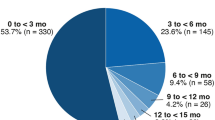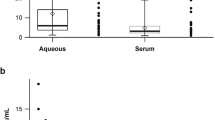Abstract
Purpose
To evaluate anatomical and visual results of eyes with naive myopic choroidal neovascularization (mCNV) in patients treated with intravitreal anti-vascular endothelial growth factor (VEGF) therapies.
Material and methods
This is a retrospective, non-randomized, comperative, intervetional study. One hundred fourteen eyes of 114 patients with mCNV who underwent intravitreal bevacizumab (IVB), intravitreal ranibizumab (IVR) or intravitreal aflibercept (IVA) monotherapy injections were enrolled into the study. The best corrected visual acuity (BCVA), central macular thickness (CMT) and subfoveal choroidal thickness (SFCT) were compared among the groups during the follow-up periods at the beginning, months 1, 3, 6, 12, and the final visit.
Results
The mean age of the patients was 47.76 ± 10.57 years (range, 33–72 years) and the mean follow-up period was 23.34 ± 6.81 months (range, 13–38 months). The mean BCVA denoted a significantly improve at each group (p < 0.05). In terms of an inter-group analysis of all 3 groups, at months 1, 6, and 12 and final visit, the BCVA were statistically significantly better in the IVA group when compared to both IVB and IVR groups (p = 0.021, p = 0.032, p = 0.024, p = 0.012). There was a significant decrease in CMT following IVB (236.49 ± 40.91 μm–190.74 ± 50.12 μm), IVA (232.91 ± 46.29 μm–193.73 ± 46.81 μm) and IVR (234.78 ± 45.37 μm–192.21 ± 37.27 μm) between baseline and final visit (p = 0.018, p = 0.002, p < 0.001, respectively). There was a statistically significant decrease in SFCT values between baseline and final examination only in the IVA group (p < 0.001). The mean number of injections were 9.18 ± 3.18 (range; 3 to 13) in IVB, 6.46 ± 2.93 (range; 3–11) in IVR and 4.45 ± 1.42 (range; 2–7) in IVA (p = 0.028).
Conclusion
All three anti-VEGFs were found to be effective in terms of visual results in patients with mCNV. However, we demonstrated that IVA reduces the need for anti-VEGF when compared to patients who received both IVB and IVR. Furthermore, IVA induced a prominent reduction in SFCT, whereas IVR and IVB did not have a significant action on SFCT.





Similar content being viewed by others
References
Grossniklaus HE, Green WR (1992) Pathological findings in pathologic myopia. Retina 12:127–133
Pierro L, Camesasca FI, Mischi M, Brancato R (1992) Peripheral retinal changes and axial myopia. Retina 12:12–17
Celorio JM, Pruett RC (1991) Prevalence of lattice degeneration and its relation to axial length in severe myopia. Am J Ophthalmol 111:20–23
Neelam K, Cheung CMG, Ohno-Matsui K, Lai TYY, Wong TY (2012) Choroidal neovascularization in pathological myopia. Prog Retin Eye Res 31:495–525
Cohen SY, Laroche A, Leguen Y, Soubrane G, Coscas GJ (1996) Etiology of choroidal neovascularization in young patients. Ophthalmology 103:1241–1244
Kojima A, Ohno-Matsui K, Teramukai S et al (2006) Estimation of visual outcome without treatment in patients with subfoveal choroidal neovascularization in pathologic myopia. Graefes Arch Clin Exp Ophthalmol 244:1474–1479
Bottoni F, Tilanus M (2001) The natural history of Juxtafoveal and Subfoveal choroidal neovascularization in high myopia. Int Ophthalmol 24:249–255
Montero JA, Ruiz-Moreno JM (2003) Verteporfin photodynamic therapy in highly myopic subfoveal choroidal neovascularisation. Br J Ophthalmol 87(2):173–176
Cohen SY (2009) Anti-VEGF drugs as the 2009 first-line therapy for choroidal neovascularization in pathologic myopia. Retina 29:1062–1066
Iacono P, Parodi MB, Papayannis A et al (2012) Intravitreal ranibizumab versus bevacizumab for treatment of myopic choroidal neovascularization. Retina 32:1539–1546
Lalwani GA, Rosenfeld PJ, Fung AE et al (2009) A variable-dosing regimen with intravitreal ranibizumab for neovascular age-related macular degeneration: year 2 of the PrONTO Study. Am J Ophthalmol 148(1):43–58
Bland JM, Altman DG (2012) Agreed statistics: measurement method comparison. Anesthesiology 116:182–185
Cohen SY, Nghiem-Buffet S, Grenet T et al (2015) Long-term variable outcome of myopic choroidal neovascularization treated with ranibizumab. Jpn J Ophthalmol 59(1):36–42
Wang E, Chen Y (2013) Intravitreal anti-vascular endothelial growth factor for choroidal neovascularization secondary to pathologic myopia: systematic review and meta-analysis. Retina 33(7):1375–1392
Wolf S, Balciuniene VJ, Laganovska G, RADIANCE Study Group et al. (2014) RADIANCE: a randomised controlled study of ranibizumab in patients with choroidal neovascularization secondary to pathologic myopia. Ophthalmology 121:682–692
Tufail A, Narendran N, Patel PJ et al (2013) Ranibizumab in myopic choroidal neovascularization: the 12-month results from the REPAIR study. Ophthalmology 120(9):1944–1945
Hefner L, Riese J, Gerding H (2013) Three years follow-up results of ranibizumab treatment for choroidal neovascularization secondary to pathologic myopia. Klin Monatsbl Augenheilkd 230(4):401–404
Monés JM, Amselem L, Serrano A, Garcia M, Hijano M (2009) Intravitreal ranibizumab for choroidal neovascularization secondary to pathologic myopia: 12-month results. Eye (Lond) 23(6):1275–80
Ikuno Y, Ohno-Matsui K, Wong TY, Investigators MYRROR et al (2015) Intravitreal aflibercept injection in patients with myopic choroidal neovascularization: the MYRROR study. Ophthalmology 122:1220–1227
Ferrara N, Kerbel RS (2005) Angiogenesis as a therapeutic target. Nature 438:967–974
Klettner A, Recber M, Roider J (2014) Comparison of the efficacy of aflibercept, ranibizumab, and bevacizumab in an RPE/choroid organ culture. Graefes Arch Clin Exp Ophthalmol 252:1593–1598
Stewart MW (2011) What are the half-lives of ranibizumab and aflibercept (Trap-eye VEGF) in human eyes? Calculations with a mathematical model. Eye Rep 1:5
Krohne TU, Liu Z, Holz FG, Meyer CH (2012) Intraocular pharmacokinetics of ranibizumab following a single intravitreal injection in humans. Am J Ophthalmol 154(4):682-686.e2
Park SJ, Choi Y, Na YM et al (2016) Intraocular pharmacokinetics of intravitreal Aflibercept (Eylea) in a rabbit model. Investig Ophthalmol Vis Sci 57(6):2612–2617
Edington M, Connolly J, Chong NV (2017) Pharmacokinetics of intravitreal anti-VEGF drugs in vitrectomized versus non-vitrectomized eyes. Expert Opin Drug Metab Toxicol 13(12):1217–1224
Krohne TU, Muether PS, Stratmann NK et al (2015) Influence of ocular volume and lens status on pharmacokinetics and duration of action of intravitreal vascular endothelial growth factor inhibitors. Retina 35(1):69–74
Bakri SJ, Snyder MR, Reid JM et al (2007) Pharmacokinetics of intravitreal ranibizumab (Lucentis). Ophthalmology 114:2179–2182
Gaudreault J, Fei D, Beyer JC et al (2007) Pharmacokinetics and retinal distribution of ranibizumab, a humanized antibody fragment directed against VEGF-A, following intravitreal administration in rabbits. Retina 27:1260–1266
Ng DS, Kwok AKH, Chan CW (2012) Anti-vascular endothelial growth factor for myopic choroidal neovascularization. Clin Exp Ophthalmol 40:e98–e110
Peace A, Milani P (2016) Intravitreal aflibercept for myopic choroidal neovascularization. Graefes Arch Clin Exp Ophthalmol 254:2327–2332
Sayanagi K, Uematsu S, Hara C et al (2019) Effect of intravitreal injection of aflibercept or ranibizumab on chorioretinal atrophy in myopic choroidal neovascularization. Graefes Arch Clin Exp Ophthalmol 257:749–757
Cha DM, Kim TW, Heo JW et al (2014) Comparison of 1-year therapeutic effect of ranibizumab and bevacizumab for myopic choroidal neovascularization: a retrospective, multicenter, comparative study. BMC Ophthalmol 14:69
Lai TYY, Luk FOJ, Lee GKY, Lam DSC (2012) Long-term outcome of intravitreal anti-vascular endothelial growth factor therapy with bevacizumab or ranibizumab as primary treatment for subfoveal myopic choroidal neovascularization. Eye (Lond) 26(7):1004–1011
El-Shazly AA, Farweez YA, El-Sebaay ME, El-Zawahry WMA (2017) Correlation between choroidal thickness and degree of myopia assessed with enhanced depth imaging optical coherence tomography. Eur J Ophthalmol 27(5):577–584
Flores-Moreno I, Lugo F, Duker JS, Ruiz-Moreno JM (2013) The relationship between axial length and choroidal thickness in eyes with high myopia. Am J Ophthalmol 155(2):314–319
Gupta P, Cheung CY, Saw S-M et al (2016) Choroidal thickness does not predict visual acuity in young high myopias. Acta Ophthalmol 94(8):e709–e715
Chen W, Song H, Xie S, Han Q, Tang X, Chu Y (2015) Correlation of macular choroidal thickness with concentrations of aqueous vascular endothelial growth factor in high myopia. Curr Eye Res 40(3):307–13
Moriyama M, Ohno-Matsui K, Futagami S et al (2007) Morphology and long-term changes of choroidal vascular structure in highlymyopic eyes with and without posterior staphyloma. Ophthalmology 114:1755–1762
Ding X, Li J, Zeng J et al (2011) Choroidal thickness in healthy Chinese subjects. Investig Ophthalmol Vis Sci 52(13):9555–9560
Wei WB, Xu L, Jonas JB et al (2013) Subfoveal choroidal thickness: the Beijing eye study. Ophthalmology 120(1):175–80
Nishijima K, Ng Y-S, Zhong L et al (2007) Vascular endothelial growth factor-A is a survival factor for retinal neurons and a critical neuroprotectant during the adaptive response to ischemic injury. Am J Pathol 171:53–67
Adamis AP, Shima DT (2005) The role of vascular endothelial growth factor in ocular health and disease. Retina 25:111–118
Fujiwara A, Shiragami C, Shirakata Y, Manabe S, Izumibata S, Shiraga F (2012) Enhanced depth imaging spectral-domain optical coherencetomography of subfovealchoroidal thickness in normalJapanese eyes. Jpn J Ophthalmol 56:230–235
You QS, Peng XY, Xu L, Chen CX, Wang YX, Jonas JB (2014) Myopic maculopathy imaged by optical coherence tomography: the Beijing eye study. Ophthalmology 121:220–224
Funding
This research received no specific grant from any funding agency in the public, commercial, or not for-profit sectors.
Author information
Authors and Affiliations
Corresponding author
Ethics declarations
Conflict of interest
Author Bugra Karasu declares that he has no conflict of interest. Author Ali Rıza Cenk Celebi declares that he has no conflict of interest.
Ethical approval
All procedures performed in studies involving human participants were in accordance with the ethical standards of the institutional and/or national research committee and with the 1964 Helsinki declaration and its later amendments or comparable ethical standards.
Informed consent
Informed consent was obtained prior to every surgical procedure from all individual participants included in the study.
Additional information
Publisher's Note
Springer Nature remains neutral with regard to jurisdictional claims in published maps and institutional affiliations.
Rights and permissions
About this article
Cite this article
Karasu, B., Celebi, A.R.C. The efficacy of different anti-vascular endothelial growth factor agents and prognostic biomarkers in monitoring of the treatment for myopic choroidal neovascularization. Int Ophthalmol 42, 2729–2740 (2022). https://doi.org/10.1007/s10792-022-02261-1
Received:
Accepted:
Published:
Issue Date:
DOI: https://doi.org/10.1007/s10792-022-02261-1




